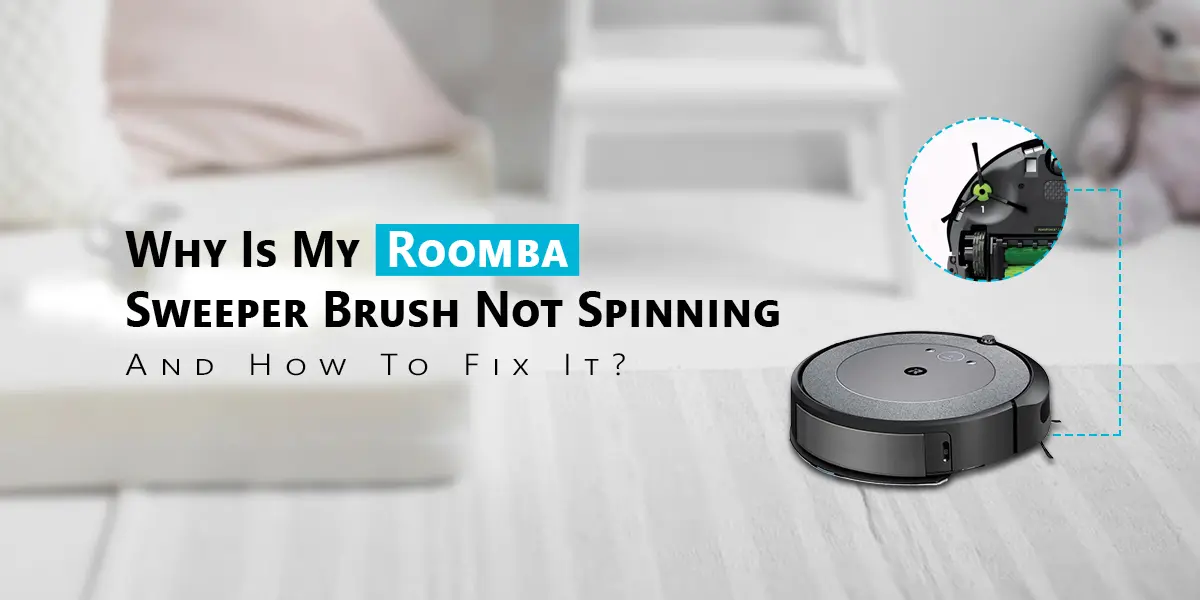
Few inventions have sparked as much interest in the realm of automated home cleaning as the Roomba. The capacity of these tiny, robotic vacuums to autonomously navigate rooms and clean floors has completely changed the way many of us maintain a clean and organized house. However, Roombas occasionally experience problems, just like any other piece of technology. The sweeper brush on a Roomba may stop spinning, which is a regular issue. This can be annoying, but don’t worry—we’ll discuss why it occurs and offer some solutions in this blog post.
Recognizing the Issue
A Roomba’s sweeper brush is an essential component of the cleaning process. This brush, which is situated beneath the vacuum, is in charge of removing dirt, dust, and other debris from the floor so that the Roomba’s suction can effectively gather it up. The effectiveness of the Roomba’s cleaning is greatly diminished when the sweeper brush stops rotating.
The sweeper brush of your Roomba may not be rotating for a few reasons:
- Obstructions: Hair, string, or other debris wrapped around the brush or lodged in its bearings is one of the most frequent causes of a non-spinning brush.
- Clogged Brush Compartment: The sweeper brush’s ability to spin freely can occasionally be hindered by debris building up in the compartment housing it.
- Problems with the motor: The brush won’t spin if the motor is broken or has burned out.
- Software or Sensor Issues: The Roomba’s software or sensors may occasionally have problems that prevent the brush from operating as intended.
How to Solve the Issue
Now that we are aware of a few possible reasons, let’s investigate troubleshooting and solution methods:
Turn off and examine
Turn off your Roomba first, then turn it over so you can reach the underside. Look for any obvious obstacles, like hair, string, or dirt, on the sweeper brush. If any tangled hair or debris is coiled around the brush, carefully remove it using scissors or the Roomba cleaning tool.
Empty the Brush Compartment.
Examine the container holding the sweeper brush after that. Clear away any dirt or debris that might be preventing the brush from rotating correctly. Hard-to-reach places can benefit from the use of a can of compressed air or a small portable vacuum.
Examine any potential mechanical problems.
If the brush is clear of debris and clean, but it is still not spinning, the motor might be the problem. To test whether the brush travels freely, try manually rotating it. Should it not, it might be necessary to replace the motor. Get in touch with Roomba customer service to schedule a repair or for more help.
Turn off and restart
Restarting the computer or doing a reset can sometimes fix software-related problems. To reset Roomba, press the Clean button for ten seconds. This operation can frequently fix little bugs and get the sweeper brush back to working order.
Examine the connections and sensors.
Make sure there are no dirt or debris lodged in any of the sweeper brush’s sensors or connections. The brush may malfunction occasionally due to a clog in the sensor or a loose connection. Any visible sensors should be gently cleaned with a cotton swab or soft cloth.
Run a System Update
Roomba occasionally releases software updates that fix recognized problems with the functionality of the brush. If there are any updates available, check the Roomba app or the manufacturer’s website and install them according to the instructions.
Speak with Customer Service
It could be time to get in touch with Roomba customer service if you’ve tried all of the aforementioned solutions and the sweeper brush on your machine is still not spinning. They can help you with additional troubleshooting or offer advice on the best course of action, which can involve having your Roomba repaired.
Upkeep Advice to Avoid Future Problems
Consider putting these maintenance suggestions into practice to keep your Roomba operating efficiently and avoid more sweeper brush issues:
- Regular Cleaning: To avoid debris buildup, clean the sweeper brush and its container after each usage.
- Examine the Brush for Obstructions: Occasionally examine the brush for hair, string, or other debris that could get in the way of its motion.
- Maintain Clean Sensors: Make sure that there is no dirt or dust on any of the sensors or connections.
- Plan Maintenance: To extend the life of your robot vacuum, adhere to Roomba’s suggested maintenance schedule.
Final thoughts
Even while difficulties with the sweeper brush on your Roomba can be annoying, it’s crucial to keep in mind that most issues have simple fixes. You can make sure that your Roomba cleans your house efficiently for many years to come by employing excellent maintenance practices and following the troubleshooting instructions provided in this blog post. Never hesitate to contact Roomba’s customer service for knowledgeable advice if you’re ever unclear about how to handle a problem.